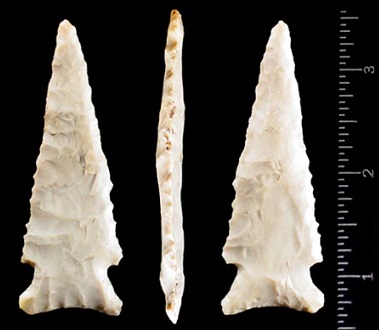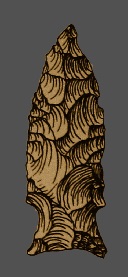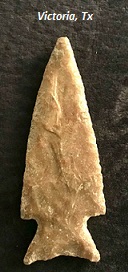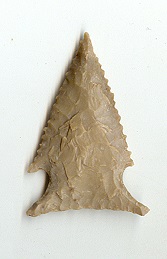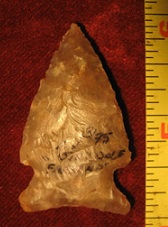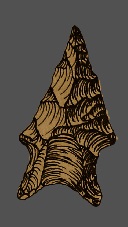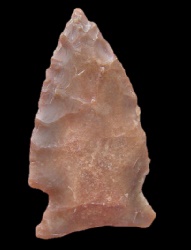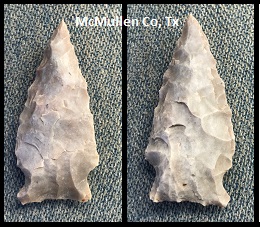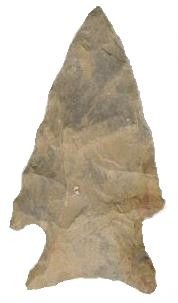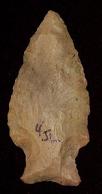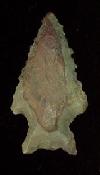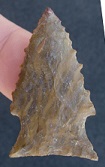Outline is Representative of Size and Shape:
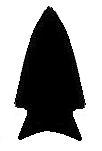
Name Details:
Identified By: J. Charles Kelly
Named For:
Date Identified: 1947
Type Site: Lehmann Rock Shelter, Gillespie County, Texas
Identified By: J. Charles Kelly
Named For:
Date Identified: 1947
Type Site: Lehmann Rock Shelter, Gillespie County, Texas
Point Validity:
Valid type
Kelley was a distinguished anthropologist who served as Curator of the Archaeological Museum at the University of Texas-Austin and was instrumental in setting up the Department of Anthropology at the University of Texas-Austin. He specialized in the archaeology of western Texas. This type was named in a professional publication and has many professional references. This is considered a valid type.
Kelley was a distinguished anthropologist who served as Curator of the Archaeological Museum at the University of Texas-Austin and was instrumental in setting up the Department of Anthropology at the University of Texas-Austin. He specialized in the archaeology of western Texas. This type was named in a professional publication and has many professional references. This is considered a valid type.
Fairland Expanding Stem
Cluster: Description of Physical Characteristics and Flaking Pattern:
This is a medium (typically 1.5 to 2.5 inches) triangular expanding stem point with an elliptical cross section. The blade may range from excurvate to straight. The blade is commonly finely serrated, but rarely beveled. The shoulders may range from horizontal to an upward angle, seldom barbed. The stem is expanding commonly as wide as the shoulders with basal and hafting region grinding typically present. Fine chipping on the base makes the base thin and auricles sharp. The base is concaved and thinned with sharp basal corners. This point has a random flaking pattern.
Size Measurements:
Total Length - 41 to 100 mm (45 mm average), Stem Length - 10 to 13 mm (12 mm average, typically making up 1/5 to 1/2 the total length), Blade Width - 23 to 38 mm (28 mm average), Neck Width - 15 to 25 mm (average 18 to 23 mm), Stem Width - 21 to 33 mm (26 mm average), Thickness -8 to 13 mm
Total Length - 41 to 100 mm (45 mm average), Stem Length - 10 to 13 mm (12 mm average, typically making up 1/5 to 1/2 the total length), Blade Width - 23 to 38 mm (28 mm average), Neck Width - 15 to 25 mm (average 18 to 23 mm), Stem Width - 21 to 33 mm (26 mm average), Thickness -8 to 13 mm
Commonly Utilized Material:
Additional Comments:
This type can be difficult to distinguish from the Edgewood type which has similar distribution and time line. It is generally thought that Edgewood points are smaller (30 to 50 mm in length Fairland 41 to 70 mm in length) with the same width making Edgewood broader than the Fairland point. However, it has been argued that these two types may represent the same type. In examples provided by Suhm and Krieger (1954), they note that examples that they show for Edgewood points (plate 88) may contain Fairland points and examples provided for Fairland points (plate 91) may contain Edgewood points due to the difficulty distinguishing the two types.
This point maybe difficult to distinguish from the Darl point. The Darl point is generally wider and beveled where this point has a narrower blade and beveling is not present (Johnson et al. 2002).
This type can be difficult to distinguish from the Edgewood type which has similar distribution and time line. It is generally thought that Edgewood points are smaller (30 to 50 mm in length Fairland 41 to 70 mm in length) with the same width making Edgewood broader than the Fairland point. However, it has been argued that these two types may represent the same type. In examples provided by Suhm and Krieger (1954), they note that examples that they show for Edgewood points (plate 88) may contain Fairland points and examples provided for Fairland points (plate 91) may contain Edgewood points due to the difficulty distinguishing the two types.
This point maybe difficult to distinguish from the Darl point. The Darl point is generally wider and beveled where this point has a narrower blade and beveling is not present (Johnson et al. 2002).
Distribution: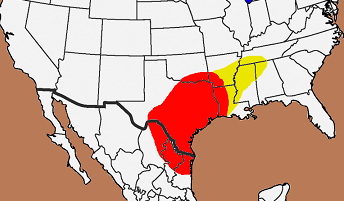

Distribution Comments:
This point is primarily found in central Texas and into northeastern Chihuahua, northern Nuevo Leon, and northern Tamaulipas. This type is found commonly, but with diminished frequency into western Louisiana, southwestern Arkansas and southern Oklahoma. (red). Limited professional references have placed this type into the Tennessee River Valley and the remaining areas in yellow.
This point is primarily found in central Texas and into northeastern Chihuahua, northern Nuevo Leon, and northern Tamaulipas. This type is found commonly, but with diminished frequency into western Louisiana, southwestern Arkansas and southern Oklahoma. (red). Limited professional references have placed this type into the Tennessee River Valley and the remaining areas in yellow.
Age / Periods:
Date: 3,000 - 1,500 B.P.
Cultural Period: Woodland
Glacial Period: Neoglacial to Roman Warm
Culture:
Date: 3,000 - 1,500 B.P.
Cultural Period: Woodland
Glacial Period: Neoglacial to Roman Warm
Culture:
Age Details:
Similar Points:
Bakers Creek, Collins, Darl, Ellis, Edgewood, Greenbrier, Hardaway, Jakie, Johnson, Limestone, Marcos, Marshall, Orient, Uvalde, Zephyr
Bakers Creek, Collins, Darl, Ellis, Edgewood, Greenbrier, Hardaway, Jakie, Johnson, Limestone, Marcos, Marshall, Orient, Uvalde, Zephyr
Other points in this cluster / Related / Associated Points:

